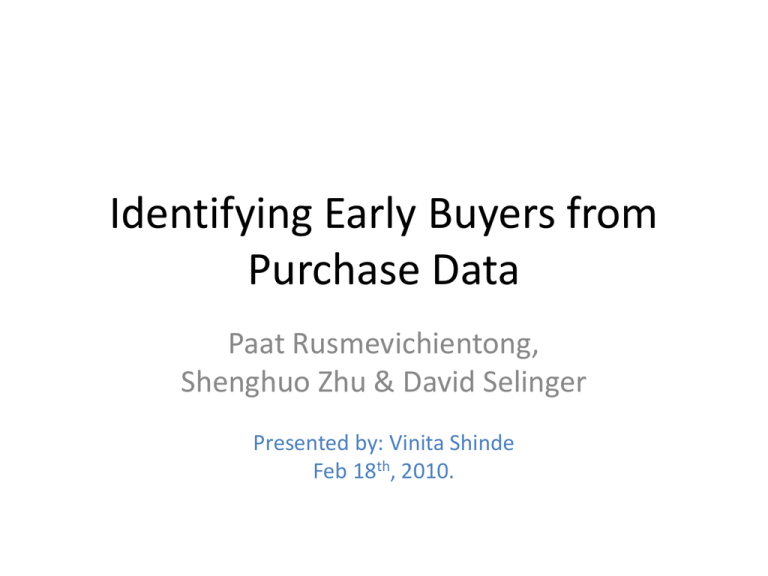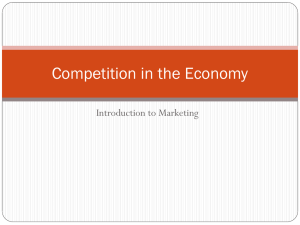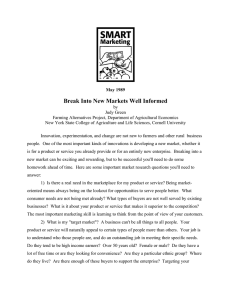Identifying Early Buyers from Purchase Data Paat Rusmevichientong, Shenghuo Zhu & David Selinger
advertisement

Identifying Early Buyers from
Purchase Data
Paat Rusmevichientong,
Shenghuo Zhu & David Selinger
Presented by: Vinita Shinde
Feb 18th, 2010.
Outline
• Motivation/Aim
• Problem Formulation
• MAX-CUT Problem
• Probabilistic Interpretation
• Algorithm
• Experiments
Why Care?
• Consumers exhibit variety of different
purchasing behaviors- some tend to purchase
products earlier than others
• Can help personalize marketing strategies
• Predict product trends, forecast sales or guide
new product information
Aim
• Identify consumers who tend to purchase
products before other consumers
• Don’t know if these early buyers influence late
buyers to adopt these products
• Provide an approximation algorithm
• Apply this algorithm to real purchase data
from Amazon.com
Basic Idea
• Input: Detailed purchase information of each
consumer (including date & time)
• Construct a weighted directed graph, whose
nodes correspond to consumers & edges
correspond to purchases that consumers have
in common
• Edge weights correspond to how frequently
consumers purchase products earlier than
others
Problem Formulation
• Assume, we have ‘M’ consumers: 1, 2, …, M
and ‘n’ products
Represent this using Directed Weighted Graph
G (V,V V,w)
where each node v ∈ V={1, . . . ,M } corresponds to a
consumer
The mapping w : V × V → R+ represents the non-negative
weight on each edge.
• We have an edge(i,j)∈V×V with weight
w ij ≥ 0 if, among the products that consumer i and j
bought in common, w ij of these products were
bought by i before j
w ij = 0 means
that either consumer i and j never
bought any product in common, or that consumer i
always purchased them after consumer j
Formulation as MAX-CUT
• Since weight of each edge measures how
frequently a consumer bought products before another consumer, formulate the
problem as a Maximum cut problem
• Hence, find a subset S ⊆ V with maximum
weights of the outgoing edges
(Weighted) MAX-CUT
• A cut is a partition of the vertices of a graph
into two disjoint subsets
• MAX-CUT: A cut whose size is not smaller than
the size of any other cut.
• We want a subset S of the vertex set such that
the total weight of the edges between S and
its complementary subset is as large as
possible.
MAX-CUT Problem
• Given an undirected graph G (V, E) and nonnegative weights w ij = w ji on edges (i, j) E
find the set of vertices
the
S that maximizes
weight of the edges in thecut (S,S) ,
Weight of the cut is denoted by
w(S,S)
w
iS, j S
ij
Example
• Assume we have three customers {1, 2, 3} and
following four edges with non-zero weights.
1
10
3
9
2
3
3
Early buyer (as per MAX-CUT formulation) is {1}, but {1} has
bought more products than {2} only slightly more than half of
the time.
• Early buyers should correspond to customers
who bought more products earlier relative to
other consumers take into account
incoming edges as well
max
Y V
(w
ij
w ji )
(i, j )Y Y
• Can put different weights on incoming and
outgoing
edges : EARLY BUYERS
max
Y V
(w
(i, j )Y Y
ij
w ji )
Probabilistic Interpretation
• p1 is the probability than an early buyer will
purchase a product before late buyer
• Find an assignment x (x1,..., x M ) {0,1}M that
maximizes the likelihood of graph G
• So, we compute
the
log-likelihood
l(x1,...,xM )
and find that
log 2p1 and log 2(1 p1)
EARLY BUYERS
(Formal Definition)
• For any 0 and 0 let Z MAX (, ) denotes the
optimal value of the EARLY BUYERS (G, , )
problem
Z
MAX
(, ) max Y V
( w
(i, j )Y Y c
ij
w ji )
Algorithms
A Special Case when
• For 0
Z MAX (, )
(w
ij
w ji )
(i, j )SG SGc
where SG {i V :
jV
wij
jV
w ji}
• Can determine the optimal cut from the
difference, at each node, between the weights
of outgoing and incoming edges
Algorithms-General
and
• Formulate the EARLY BUYERS problem as an
Integer Quadratic Programming
w ij
Maximize i, j f ij (y 0, y i , y j )
4
Subject to: yi {1,1}, i
where for any (i, j) V V,
f ij
(y 0, y i , y j ) (( )(1 y i .y j ) ( )y 0 .(y i y j ))
4
4
0
y0 yi
and
y0 y j
and
otherwise
yi y j
yi y j
• Relax to Semi-Definite Programming problem
1. Solve (P) & obtain solutions v 0,...,v n
Here, vi Sn and Sn denotes the n-dimensional unit sphere
2. Generate a random vector r that is uniformly
distributed on Sn
3. Define y1,..., yn as follows: yi 1 if
sgn(vi .r)
sgn( v0 .r) and yi 1 otherwise.
4. Define a cut S as {i: yi 1}
Experiment Dataset
• The top 50 most popular electronics items
sold in the year 2002 on Amazon.com chosen
as the set of products
• Consider those consumers who bought at
least four of these 50 products
• Have edge weight w ij ≥ 0 if among the 50
products that i and j have bought in common,
w ij of those products were bought by
consumer iat least 24 hours prior to
consumer j.
Performance Comparison
Algorithm
No. of Early Buyers
(as % of Total
Customers)
Objective Value
Top-Net-Weight
34.31%
700,037
SDP
48.93%
750,275
Since an early buyer is more likely to purchase a
product before a late buyer, we want p1 to exceed 0.5
Set p1 0.7 Then, 0.3365and 0.5108
For Top-Net-Weight Algorithm, set of nodes is:
S {i V :
jV
wij
jV
w ji}
Overall Purchase Characteristics
Variable
Ratio between Early &
Late Buyers (2002)
Ratio between Early &
Late Buyers (2003)
Overall Revenue
1.16
1.06
Electronics Revenue
1.15
1.02
Overall Quantity
1.16
1.05
Electronics Quantity
1.14
0.98
Ratio between early and late buyers for 2002 & 2003
Sales Distribution Over Time
Cumulative sales distribution for the year 2002 among early buyers, late
buyers, and the over- all population for a wireless notebook adapter
(a) Portable CD Player
(b) 40GB Ipod
Figure : Cumulative sales distribution in the year 2003 for (a) portable CD
player and (b) 40GB iPod. These products were not released until 2003.
Performance for Different
and
Extensions
• Scalability: SDP can handle only thousands of
customers
• No constraint on # of Early Buyers: We might
want to know top 1% of the early buyers
• Definition of Edge Weights: Can be extended
to reflect the time between purchases
• Differences in Product Life Cycles ignored
• Choices of and : estimate from data
Thank You!









